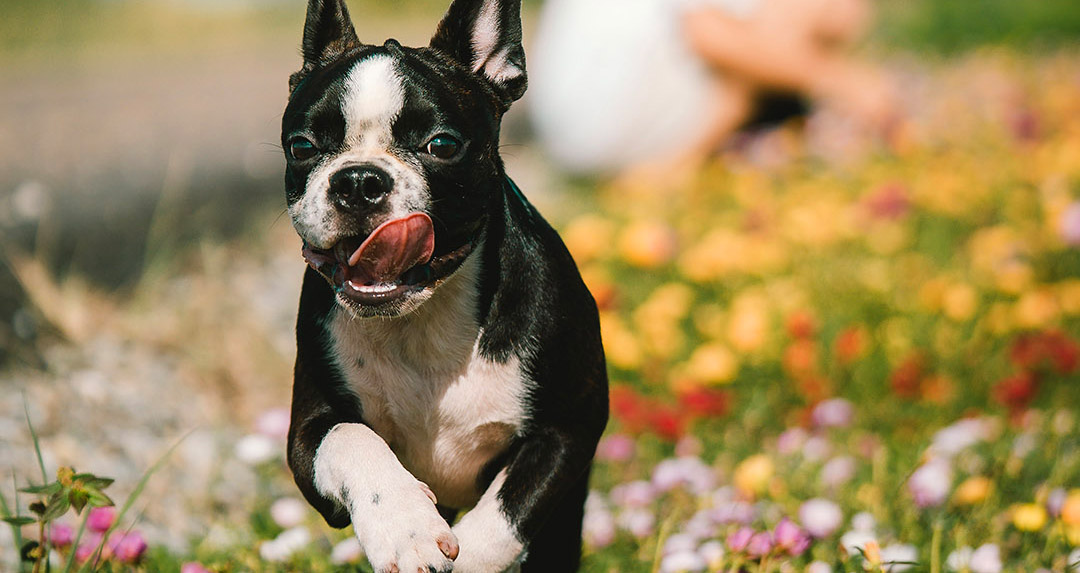Table of Contents
If your dog is anxious, over-aroused, or just can’t settle, the answer may be hiding in plain sight—right in their bowl.
For pet parents living with a nervous or reactive dog, everyday life can feel like walking on eggshells. Maybe you’re training together, providing both mental and physical enrichment through brain games and scent walks, and offering a safe, quiet space to decompress (which should absolutely be part of the approach)—but the stress still lingers, buzzing just beneath the surface.
This post is for those dogs—typically younger or middle-aged—who run emotionally hot. Dogs whose anxiety stems from excess Heat or overstimulation.
(If your dog is a senior struggling with cognitive changes, Shen Deficiency, or age-related restlessness, the approach may look very different—and often requires warming, not cooling, support.)
That’s where food energetics comes in.
In Traditional Chinese Veterinary Medicine (TCVM), food is more than nutrition—it’s energy. The right ingredients can cool an overheated system, nourish the Heart, and anchor the Shen (the spirit). And when layered with calming herbs—like those in Calm Shen for daily use or July Third for situational stress—you’re supporting your dog on multiple levels, not just managing symptoms.
While food isn’t the only piece of the puzzle, it’s one of the most foundational. And when you feed intentionally, you’re not just filling the belly—you’re helping your dog build emotional resilience from the inside out.
If your dog is anxious, over-aroused, or just can’t settle, the answer may be hiding in plain sight—right in their bowl.
For pet parents living with a nervous or reactive dog, everyday life can feel like walking on eggshells. Maybe you’re training together, providing both mental and physical enrichment through brain games and scent walks, and offering a safe, quiet space to decompress (which should absolutely be part of the approach)—but the stress still lingers, buzzing just beneath the surface.
This post is for those dogs—typically younger or middle-aged—who run emotionally hot. Dogs whose anxiety stems from excess Heat or overstimulation.
(If your dog is a senior struggling with cognitive changes, Shen Deficiency, or age-related restlessness, the approach may look very different—and often requires warming, not cooling, support.)
That’s where food energetics comes in.
In Traditional Chinese Veterinary Medicine (TCVM), food is more than nutrition—it’s energy. The right ingredients can cool an overheated system, nourish the Heart, and anchor the Shen (the spirit). And when layered with calming herbs—like those in Calm Shen for daily use or July Third for situational stress—you’re supporting your dog on multiple levels, not just managing symptoms.
While food isn’t the only piece of the puzzle, it’s one of the most foundational. And when you feed intentionally, you’re not just filling the belly—you’re helping your dog build emotional resilience from the inside out.
What Is Food Energetics?
Food Energetics is the foundation of TCVM nutrition. Every ingredient carries an energetic temperature (cooling, warming, or neutral), a direction (like upward or inward), and a specific action (like tonifying or dispersing).
It’s not about the temperature in your hand—it’s about how the food acts once it’s digested.
Think of it like this: we crave watermelon on hot days because it cools us down. Dogs are no different. Their bodies crave balance—and Food Energetics helps us offer it.
“TCVM doesn’t look at anxiety as just a behavior problem. It’s a disharmony—and food can help rebalance it.” — Dr. Chris Bessent, DVM
Anxiety Through the TCVM Lens
East Meets West: Two Perspectives on Stress
In Western veterinary medicine, anxiety is typically seen as a neurochemical imbalance—managed through behavioral training, supplements, or pharmaceuticals.
In TCVM, anxiety is viewed as a disturbance in the Heart and the Shen (think: your dog’s spirit, emotions, and sense of calm—kind of like their “inner peace”).
- The Heart is said to house the Shen (like a home base for their emotional balance).
- When the Heart is out of balance—often due to excess Heat, Yin Deficiency, or stagnation—the Shen becomes restless (your dog becomes wired, jumpy, or unable to relax).
- That’s when you see the panting, pacing, barking, or difficulty settling down.
Same symptoms—but completely different interpretations.
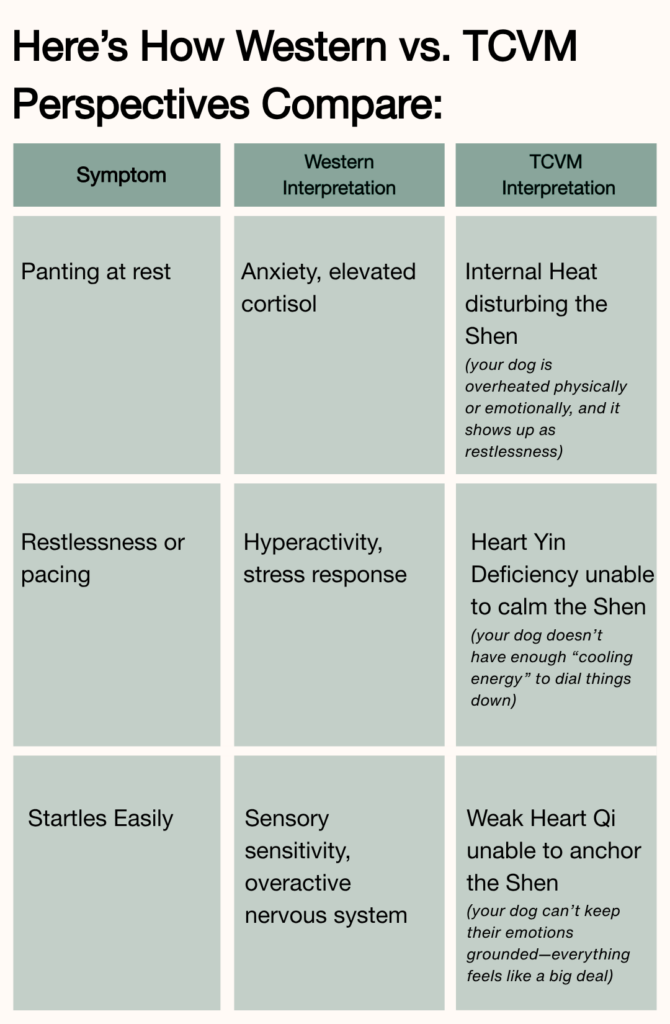
East Meets West: Two Perspectives on Stress
In Western veterinary medicine, anxiety is typically seen as a neurochemical imbalance—managed through behavioral training, supplements, or pharmaceuticals.
In TCVM, anxiety is viewed as a disturbance in the Heart and the Shen (think: your dog’s spirit, emotions, and sense of calm—kind of like their “inner peace”).
- The Heart is said to house the Shen (like a home base for their emotional balance).
- When the Heart is out of balance—often due to excess Heat, Yin Deficiency, or stagnation—the Shen becomes restless (your dog becomes wired, jumpy, or unable to relax).
- That’s when you see the panting, pacing, barking, or difficulty settling down.
Same symptoms—but completely different interpretations.
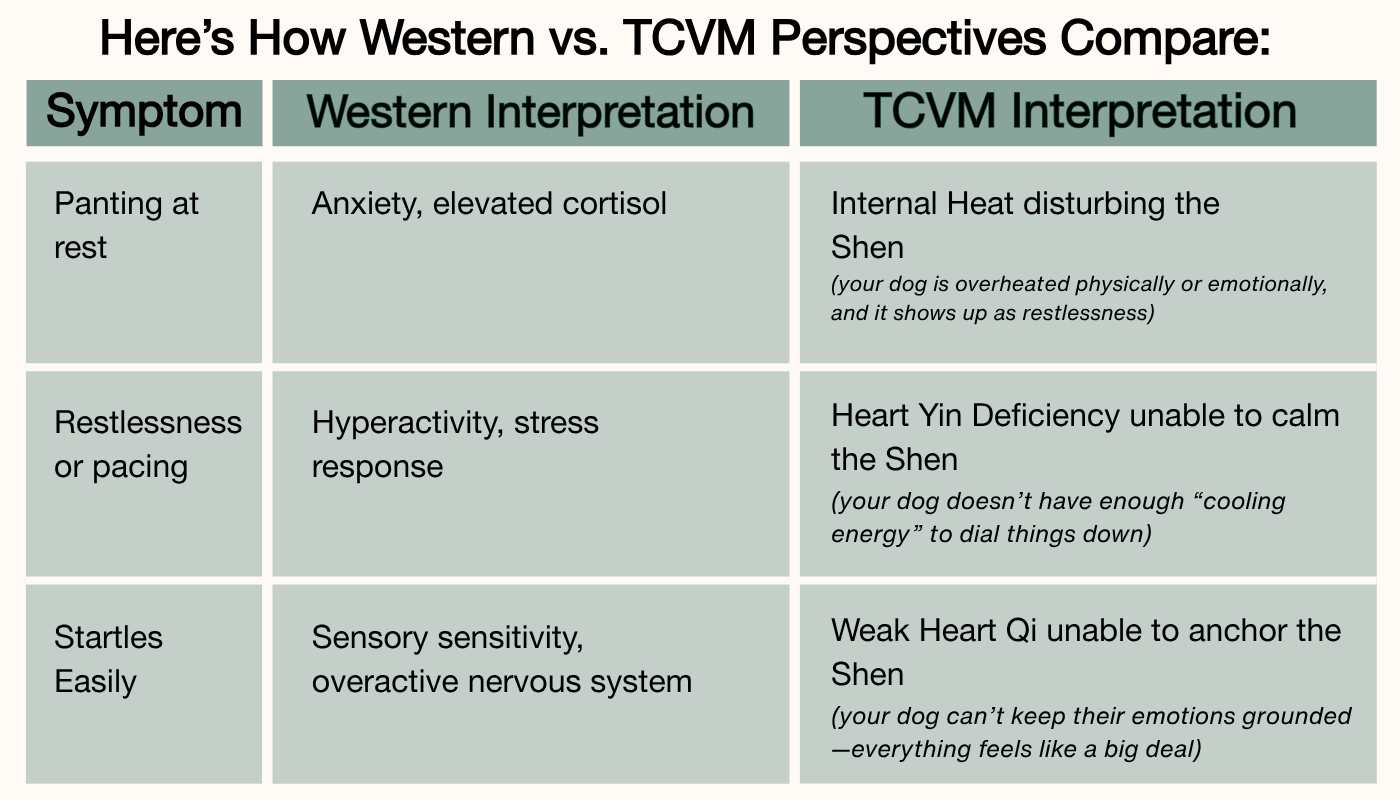
The Role of Food in Calming the Shen
To soothe an unsettled Shen (think: your dog’s spirit or emotional center when they are feeling anxious, frazzled, or overstimulated), TCVM turns to energetically cooling and neutral foods. These ingredients help release internal Heat (basically, they help your dog chill out—physically and emotionally), nourish the Heart (where the Shen “lives” in TCVM terms), and create the calm, grounded environment the Shen needs to settle (so your dog can relax and feel safe again).
The framework of Food Energetics comes from Traditional Chinese Medicine—a time-tested approach that looks at food not just as fuel, but as a way to shift the body toward balance. You can explore ingredient energetics in more depth in our TCM Food Energetics Charts →
Think of it as building a bowl that supports the whole dog—not just the behavior you’re trying to fix.
Cooling Foods That Support Calm
- Proteins like duck, rabbit, and whitefish help draw out internal Heat
- Neutral veggies like green beans and sweet potatoes support balance without contributing to excess energy
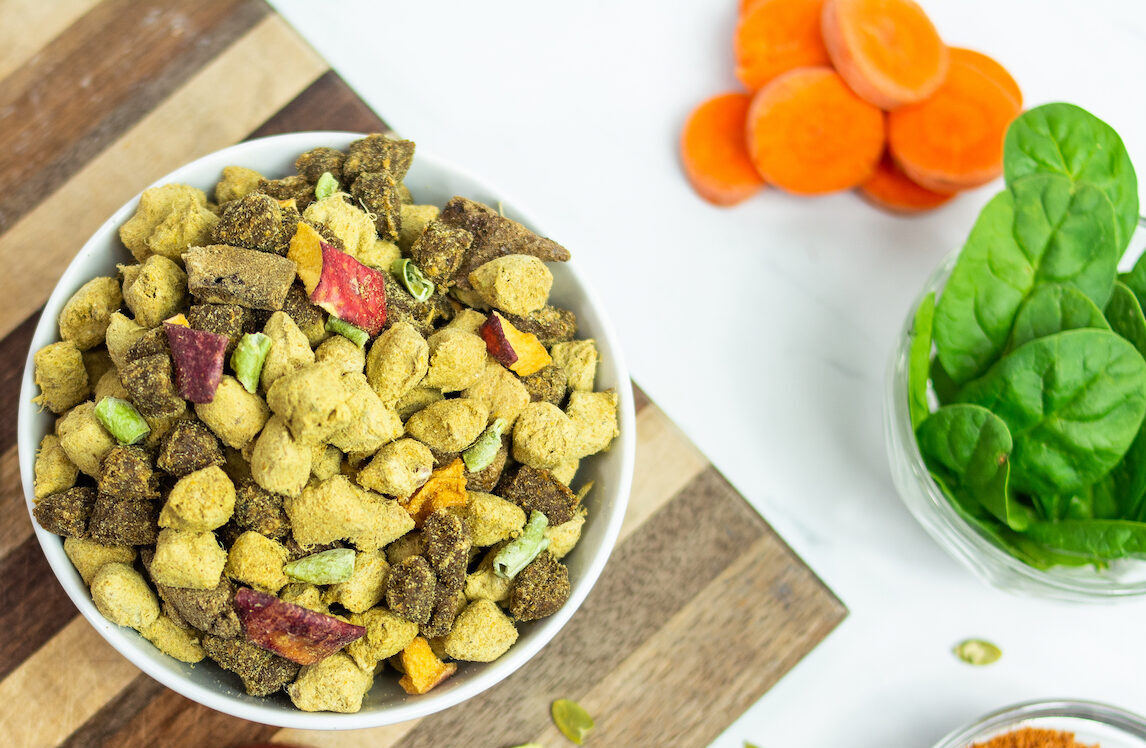
Dr. Bessent used this framework to craft cooling recipes for dogs who run hot—physically or emotionally. Both the Duck Recipe and the Duck & Trout Recipe from The Simple Food Project are made with whole, freeze-dried ingredients that reflect TCVM principles and deliver species-appropriate nutrition.
Herbs That Calm the Shen—In Two Key Ways
Calming herbs are a powerful part of this equation—but only when used intentionally.
There are two main types:
- Long-Term (Tonic) Herbs
These build resilience over time by nourishing the Heart and supporting Shen balance on a deeper level.
→ Found in formulas like Herbsmith Calm Shen
→ Best for chronic anxiety, generalized nervousness, and emotional reactivity - Fast-Acting (Acute) Herbs
These work quickly to ease stress in the moment—perfect for fireworks, car rides, vet visits, or separation.
→ Found in formulas like Herbsmith July Third
→ Best for short-term spikes in anxiety or situational stress
Here’s the key: you don’t have to choose one or the other.
In fact, long-term and fast-acting herbs work best together.
Think of it like this—Calm Shen builds your dog’s foundation, while July Third helps them navigate the bumps in the road.
Herbs and food work best when they’re part of the same plan—not treated as separate tools. That’s the heart of TCVM.
💡 Not sure which your dog needs—long-term, fast-acting, or both?
Take our quick quiz and get personalized recommendations from Dr. Bessent herself.
→ Take the quiz
Because the body isn’t a set of silos—digestion, emotion, immunity, and energy all work together. So should your approach.
Why Kibble Can Work Against Calm
Here’s the truth: you won’t find this kind of energetic balance in a bag of kibble.
Kibble is ultra processed by design—cooked at high heat, packed with starch-heavy binders, and fortified with synthetic vitamins to compensate for what’s lost in processing or never there from the beginning. From a TCM perspective, that makes it energetically hot—and that heat can fuel the very imbalance we’re trying to calm.
In other words, if your dog is already running “hot” emotionally, kibble only adds to the fire.
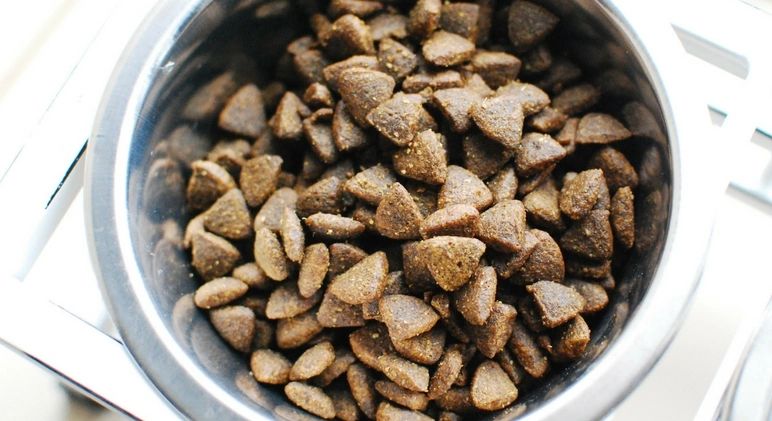
That doesn’t mean you’ve failed if your dog eats kibble. But it does mean you’re working against the body’s natural ability to regulate and restore calm.
Real change begins with real food—nutritionally appropriate, species-specific, and intentionally chosen for your dog’s unique needs.
Signs Your Dog May Benefit from Cooling Foods
- Excessive panting
- Pacing or restlessness (could also be a sign of aging or cognitive decline)
- Vocalizing for attention (may be breed-related or rooted in boredom)
- Difficulty settling at night (can also indicate pain or dementia in senior dogs)
- Reactivity during storms, car rides, or separation
Important note:
These signs can also point to other health concerns, life stages, or behavioral triggers—especially in senior dogs. That’s why it’s helpful to look at the full picture (age, temperament, environment, diet, etc.) when deciding whether cooling energetics make sense.
If your dog tends to run emotionally hot—wired, over-aroused, easily triggered—Food Energetics may help bring that energy down a notch. Naturally.
If Your dog Struggles with Anxiety, You’re Not Alone—and You’re Not Out of Options
You’re likely already doing a lot right—training, enrichment, creating a safe space. All of it plays a role.
But if your dog is still carrying stress in their body—panting, pacing, unable to settle—what’s in the bowl might be contributing, too.
Food isn’t a standalone fix, but it is a foundation.
And when it works in synergy with the rest of your approach, that’s when real change starts to stick.
Here’s how to get started:
- Observe your dog—and their bigger picture.
Are they warm to the touch? Constantly “on”? Easily triggered? Consider their age, breed, temperament, and health history when deciding whether they’re running emotionally hot—or if something deeper (like Shen Deficiency or cognitive decline) could be at play.
💡 Pro Tip: Stress shows up in the gut. If your anxious dog also has loose stools, gurgly digestion, or a finicky appetite, that’s a sign their system is out of balance. Calming foods and herbs often help both mood and digestion—because in TCVM, they’re connected.
- Shift toward cooling foods.
Recipes made with cooling proteins like duck or whitefish, paired with neutral veggies like mushrooms or sweet potatoes, are a great foundation for dogs showing signs of excess Heat.
💡 Pro Tip: Serve freeze-dried food rehydrated—especially if your dog runs hot. Adding a little cool or room-temp water helps support digestion, prevent dryness, and gently reinforces cooling energetics.
- Avoid warming ingredients.
Lamb, venison, and even chicken can add energetic Heat that worsens emotional reactivity in already-hot dogs.
💡 Pro Tip: Rotating in a variety of neutral foods—like beef, pork, eggs, carrots, peas, or zucchini—can help support long-term balance without overstimulating the system.
(It keeps the bowl interesting, too.)
- Layer in calming herbs—intentionally.
Use tonic herbs (like Calm Shen) daily to build emotional resilience, and acute support (like July Third) during stressful moments like storms or vet visits.
💡 Not sure what your dog needs?
Take our quick quiz and get personalized recommendations from Dr. Bessent herself.
Food Energetics isn’t a magic fix. It’s a mindful foundation.
It’s a shift that doesn’t require an overhaul—just a little more intention in the bowl.
Because ultra-processed food works against your goal of calm by raising internal Heat.
Real, species-appropriate food works with your dog to anchor the Shen and support emotional balance—every single day.

For anxious four-leggers, that foundation can change everything.
And it’s easier to start than you think.
Want to go deeper?
Explore our Anxiety Relief Guide →
Share this Post
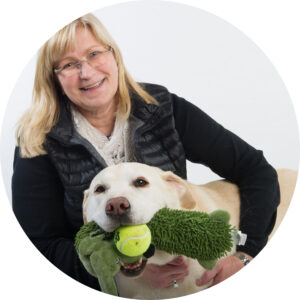
Dr. Chris Besent
Chris Bessent, DVM, MSOM, Dipl. OM, L.Ac. has over thirty years of experience in veterinary medicine including certificates in veterinary acupuncture, veterinary chiropractic and veterinary Chinese herbology. Imbued with Eastern philosophy and the knowledge that food is the foundation of health, Dr. Bessent also received her degree in veterinary nutrition and began to formulate recipes fit for a carnivore from nothing but whole foods. Currently, she divides her time between the Simple Food Project and Herbsmith, both of which are owned and operated out of her facilities in southeastern Wisconsin.

Kayla Behling - Writer
Kayla is the Content Editor for Herbsmith. She has a cat named Professor Cat-Faced Meowmers, who goes by Kitty, and a goof of a dog, named Duck. She stays busy biking trails, playing board games, and searching for the next best craft beer.
